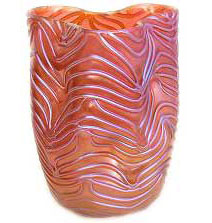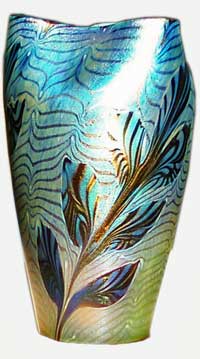Bohemian Art Glass

How Do They Do That? Spotted Glass
By null — The three photos shown below were all posted on Show & Tell by ozmarty, who has a fondness for Czech or Bohemian glass. For a very brief period, no longer than a few months, I became somewhat familiar with the technique used to produce the speckled effect seen on the bottoms of ozmarty's vases when I worked for Dale Chihuly. This was in 1983 or '84 or so, when Chihuly was in the thick of his Macchia series. Mostly my role was to cook for the crew, but occasionally they would let me...

U.S. Studio Art Glass, Before and After Chihuly
By Maribeth Keane and Brad Quinn — In 2010, we spoke with Seattle-based artist Benjamin Moore (1952-2021) about the origins of the American Studio Art Glass Movement and how it benefited from the combination of traditional European techniques and an American attitude of collaboration and experimentation. : Marvin Lipofsky introduced me to glass while I was getting a bachelor’s degree in ceramics at the California College of Arts in Oakland, California. One day I saw a poster there for the Pilchuck Glass School,...

A Classic Design in Overlay Glass
By Richmond Huntley — Overlay or cased glass was a product of the 19th Century. But, although different in technique, it stemmed back, artistically at least, to the colorful enameled glass of the Romans which they first fashioned some two thousand years ago. This process the Arabs later perfected and the Syrian glass of Damascus and Aleppo presently found its way to Europe where Venetian and, later, Bohemian glassmakers also learned the process. Glass enameling, however, involved not only the use of many...

Loetz Glass Collector Eddy Scheepers on the Pride of Bohemia
By Maribeth Keane — Loetz was a Bohemian company. It was a factory; and the region’s biggest and best glass manufacturer. There were other contemporaries like Kralik, Rindskopf, and Pallme-Konig that produced glass in the same style, made almost in the same way, but not always with the same quality. The glass is covered with vapors of metals, like silver, for instance. Most Loetz glass was not free-blown like most people think; ninety-five percent was blown in molds. Some people think some of the glasses...

Reyne Haines Spills on Tiffany, Chihuly, and Loetz
By Dave Margulius — I started becoming interested in art glass when I moved from Texas to New York, and wanted to decorate my apartment with New York-type things, things I had never seen in Houston. I grew up in Texas, which is a relatively new state. While there’s a lot of money in Texas, we didn’t have a Tiffany’s, we didn’t have a Marshall Field’s, or companies that sold Baccarat or Lalique or Tiffany or Steuben or any of the bigger makers. Nobody in my family really collected anything, and I wouldn’t say...